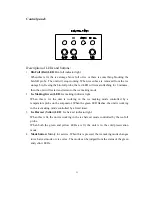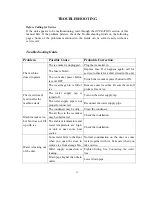
8
•
This ice maker should be properly installed by qualified personnel.
•
To ensure proper ventilation for your ice maker, the front of the unit must be
completely unobstructed.
•
When installing the ice maker under a counter, follow the recommended spacing
dimensions shown. Allow at least 4" (102 mm) clearance at rear, and 1"
(
25 mm
)
at top
and sides for proper air circulation. The installation should allow the ice maker to be
pulled forward for servicing if necessary.
•
Choose a well ventilated area with temperatures above 50°F (10°C) and below 100°F
(38°C).This unit MUST be installed in an area protected from the elements, such as
wind, rain, water spray or drips.
•
The unit
should not be located next to ovens, grills or other high heat sources.
•
Installation of the ice maker requires a cold water supply inlet of ¼-in. (6.35mm) soft
copper tubing with a shut-off valve.
•
The ice maker requires a continuous water supply with a minimum pressure of 15 psig
and a static pressure not to exceed 80 psig. The temperature of the water feeding into
the ice maker should be between 41°F (5°C) and 90°F (32°C) for proper operation.
•
It is strongly recommended that a water filter be used.
A filter, if it is of the
proper type, can remove taste and odors as well as particles. Some water is very hard,
and softened water may result in white, mushy cubes that stick together. Deionized
water is not recommended.
•
The ice maker must be installed with all electrical and water connections in accordance
with all state and local codes.
•
The unit should be located on a firm and level surface. It is important for the ice maker
to be leveled in order to work properly.
If needed, you can adjust the height of the ice
maker by revolving the caster. See the
Leveling the Ice Maker
section.
•
A standard electrical supply (115V AC only, 60Hz, 15A), properly grounded in
Normal operating ambient temperature should be between 50°F (10°C) to
100°F (38°C). Normal operating water temperature should be between 41°F
(5°C) and 90°F (32°C). Operation of the ice maker for extended periods out-
side of these normal temperature ranges may affect production capacity.










































